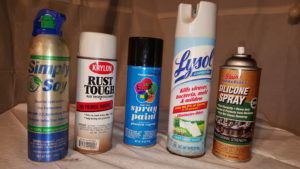If your operations generate empty – or nearly empty – aerosol cans as a waste you must be aware of your requirements as a generator of hazardous waste under the Resource Conservation and Recovery Act (RCRA). First of all, you must be aware that unless the aerosol cans meet the definition of RCRA Empty found at 40 CFR 261.7 it is subject to the requirement to perform a hazardous waste determination per 40 CFR 262.11. This determination may very well reveal that your aerosol cans are a characteristic hazardous waste for Ignitability or Reactivity, or perhaps a listed hazardous waste. Don’t panic however, RCRA includes an exemption from full regulation that can include your aerosol cans, if managed properly.
 The key is the Scrap Metal Exemption found at 40 CFR 261.6(a)(3)(ii). The exemption exists because EPA believes that some wastes – even hazardous wastes – pose a lower risk to the environment when recycled. The exemption allows for certain recycled hazardous materials (known as “recyclable materials”) to be released from full regulation as a hazardous waste under Subtitle C of RCRA.
The key is the Scrap Metal Exemption found at 40 CFR 261.6(a)(3)(ii). The exemption exists because EPA believes that some wastes – even hazardous wastes – pose a lower risk to the environment when recycled. The exemption allows for certain recycled hazardous materials (known as “recyclable materials”) to be released from full regulation as a hazardous waste under Subtitle C of RCRA.
Scrap metal is a solid waste when disposed of or recycled. However, if recycled (i.e., reclaimed to recover a usable product), the Scrap Metal Exemption can be used to exempt it from regulation as a hazardous waste. What, therefore, is a scrap metal? Defined at 40 CFR 261.1(c)(6) as, “bits and pieces of metal parts (e.g., bars, turnings, rods, sheets, wire) or metal pieces that may be combined together with bolts or soldering (e.g., radiators, scrap automobiles, railroad box cars), which when worn or superfluous can be recycled.” Some key points of the definition:
- “Bits and pieces of metal parts” or metal pieces combined to make manufactured articles. It does not include dusts, fines, or sludges.
- Must be “worn or superfluous”, i.e., no longer fit for use.
- “Can be recycled”. It must be acceptable to a recycler.
 Many items may fit into this definition, one of them is a steel aerosol can; with or without the residue of a liquid or a compressed gas. If applicable, the scrap metal exemption allows you to accumulate, store, empty, puncture, and drain your steel aerosol cans as part of the recycling process exempt from RCRA regulation. EPA does not regulate this exempt recycling process, but it does recommend you…
Many items may fit into this definition, one of them is a steel aerosol can; with or without the residue of a liquid or a compressed gas. If applicable, the scrap metal exemption allows you to accumulate, store, empty, puncture, and drain your steel aerosol cans as part of the recycling process exempt from RCRA regulation. EPA does not regulate this exempt recycling process, but it does recommend you…
- Empty the aerosols in a safe manner and in a way that protects the environment. This means don’t brace the can and whack it with a hammer and nail (I’ve seen it done) or throw it into a bonfire for kicks (don’t get any ideas).
- Capture the compressed gases and any liquid residue. The liquid residue will likely be a hazardous waste for Ignitability and possibly for a listed hazardous waste. If a filter is used to capture the released compressed gases, that will be subject to a hazardous waste determination as well.
A good way to meet the EPA recommendations is to purchase an aerosol can puncture device and install it on a DOT-Approved container. Follow the manufacturer’s instructions for use of the device, and manage the container as a satellite accumulation area for hazardous waste.
The above is based on the US EPA Federal regulations. Your state, county, or municipality may have regulations addressing the handling and disposal of aerosol cans. Also, your scrap metal recycler should be informed of your actions.
UPDATE: EPA proposed in 2018 to allow non-empty aerosol cans to be managed as a universal waste. Unless the current interruption in federal government operations continues (written 01.21.19), this should become law in 2019. This will clarify and ease the management of non-empty aerosol cans.
Not only does my RCRA Training meet the regulatory requirements for large quantity generators of hazardous waste, it also contains information that you can apply in your day-to-day operations to maintain compliance. But RCRA Training is only part of what I do. I also provide HazMat Employee Training required by the US DOT. Contact me for a free consultation on your training needs.


